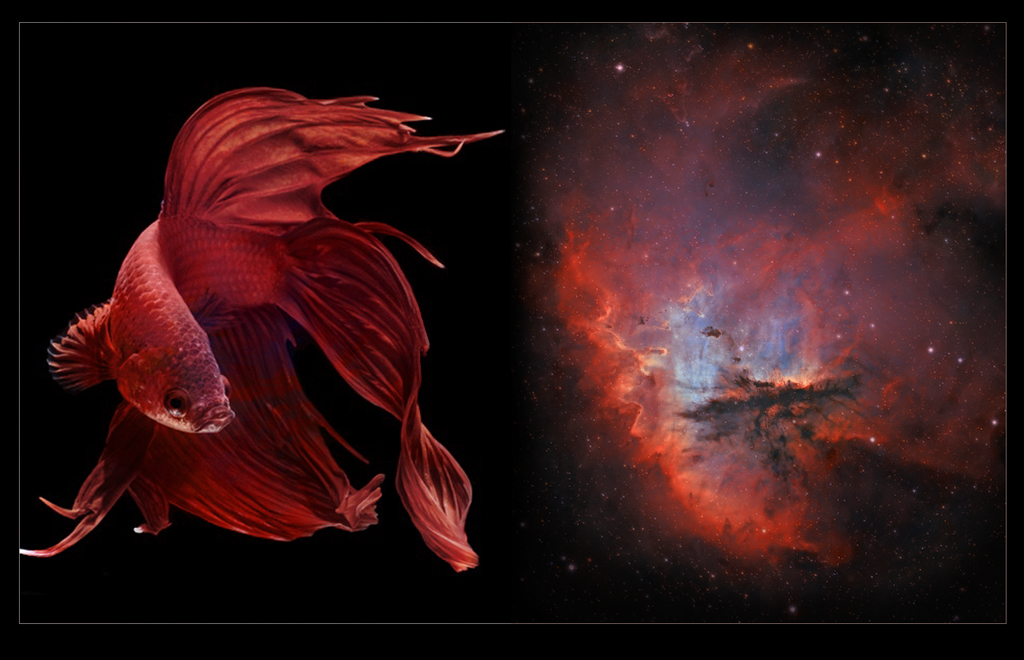COPYRIGHT, PLEASE NOTE
All the material on this website is copyrighted to J-P Metsavainio, if not otherwise stated. Any content on this website may not be reproduced without the author’s permission.
BUY A MUSEUM QUALITY POSTER
BUY A POSTER:https://astroanarchy.zenfolio.com/
Tuesday, November 4, 2014
NGC 281, the Siamese fighting fish
At 31. October I shot the raw frames for the NGC 281. Yesterday I combined them as a final color photo. When the photo was ready, I didn't saw the usual "Pac Man" figure but a Siamese fighting fish!
Mapped colors from an emission of the ionized elements, Red=Sulfur, Green=Hydrogen and the Blue =Oxygen.
Image in visual colors
Image in visual spectrum composed from the emission of ionized elements.
It does look like a Siamese fighting fish!
Source for the fighting fish image: www.petattack.com/fight-like-fighting-fish/
INFO
NGC 281 is an H II region in the constellation of Cassiopeia. It includes the open cluster IC 1590 and several Bok globules (dark doo-dads at center of the Blue area). NGC 281 is also known as the Pac-Man Nebula for its resemblance to the video game character from early 80's. NGC 281 spans over 80 light years at its estimated distance of 9500 light years.
A study about the structure
All pillar like formations are pointing to a source of ionization, the open cluster NGC 281. There are some more dense areas in a gas, able to resist the radiation pressure from young star cluster. Those dense areas, at a tip of the each pillar, are also potential places for the formations of the new stars. Note. There are some very dim outer formations in this nebula, I haven't noticed them before. Like the one pillar like at the eleven o'clock position.
A starless view
An experimental starless view shows better the actual structure of the nebula.
Technical details
Processing work flow
Image acquisition, MaxiDL v5.07.
Stacked and calibrated in CCDStack2.
Deconvolution with a CCDStack2 Positive Constraint, 33 iterations, added at 50% weight
Color combine in PS CS3
Levels and curves in PS CS3.
Imaging optics
Celestron Edge HD 1100 @ f7 with 0,7 focal reducer for Edge HD 1100 telescope
Cameras and filters
Imaging camera Apogee Alta U16 and Apogee seven slot filter wheel
Guider camera, Lodestar x2
Astrodon filter, 5nm H-alpha
Astrodon filter, 3nm O-III
Exposure times
Astrodon filter, 3nm O-III
Exposure times
H-alpha, 9 x 1200s = 3h
O-III, 3 x 1200s = 1h
S-II, 3x1200s = 1h
S-II, 3x1200s = 1h
A single un cropped, calibrated and stretched 20 min. H-alpha frame
A sample image of Tonemapped channels
I'm using a special processing technique of mine for a weak signal, the Tone Mapping v2
Starless emission channels are much easier to process for color channels since I don't need to worry about bloating stars etc. In HST-palette, the idea is to have all the channels in equal weight in the final color image. To do that, tens of times more exposure time is needed for a weaker channels, usually O-III or S-II. Typically it's not possible in any reasonable time frame and weaker channels needs to be stretched very strongly. Doe to that, lots of artifacts are generated, like purple stars. With my technique a perfect color balance is easily done.
Labels:
Narrowband color images,
nebula
Subscribe to:
Post Comments (Atom)

















No comments:
Post a Comment